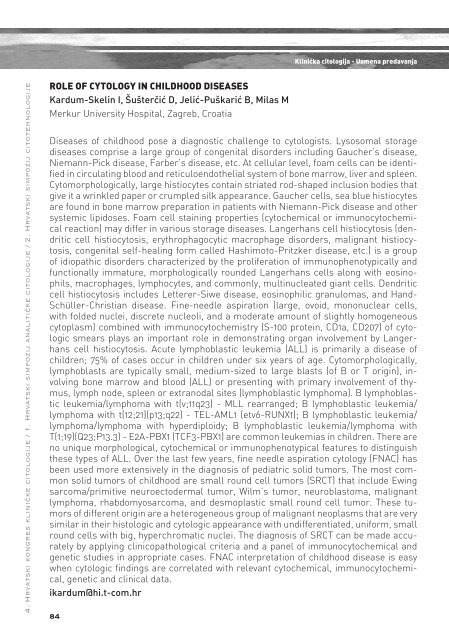4. Hrvatski kongres kliniËke citologije 4th Croatian Congress ... - Penta
4. Hrvatski kongres kliniËke citologije 4th Croatian Congress ... - Penta
4. Hrvatski kongres kliniËke citologije 4th Croatian Congress ... - Penta
You also want an ePaper? Increase the reach of your titles
YUMPU automatically turns print PDFs into web optimized ePapers that Google loves.
<strong>4.</strong> <strong>Hrvatski</strong> <strong>kongres</strong> <strong>kliniËke</strong> <strong>citologije</strong> / 1. <strong>Hrvatski</strong> simpozij analitiËke <strong>citologije</strong> / 2. <strong>Hrvatski</strong> simpozij citotehnologije<br />
ROLE OF CYTOLOGY IN CHILDHOOD DISEASES<br />
Kardum-Skelin I, Šušterčić D, Jelić-Puškarić B, Milas M<br />
Merkur University Hospital, Zagreb, Croatia<br />
84<br />
Klinička citologija - Usmena predavanja<br />
Diseases of childhood pose a diagnostic challenge to cytologists. Lysosomal storage<br />
diseases comprise a large group of congenital disorders including Gaucher’s disease,<br />
Niemann-Pick disease, Farber’s disease, etc. At cellular level, foam cells can be identified<br />
in circulating blood and reticuloendothelial system of bone marrow, liver and spleen.<br />
Cytomorphologically, large histiocytes contain striated rod-shaped inclusion bodies that<br />
give it a wrinkled paper or crumpled silk appearance. Gaucher cells, sea blue histiocytes<br />
are found in bone marrow preparation in patients with Niemann-Pick disease and other<br />
systemic lipidoses. Foam cell staining properties (cytochemical or immunocytochemical<br />
reaction) may differ in various storage diseases. Langerhans cell histiocytosis (dendritic<br />
cell histiocytosis, erythrophagocytic macrophage disorders, malignant histiocytosis,<br />
congenital self-healing form called Hashimoto-Pritzker disease, etc.) is a group<br />
of idiopathic disorders characterized by the proliferation of immunophenotypically and<br />
functionally immature, morphologically rounded Langerhans cells along with eosinophils,<br />
macrophages, lymphocytes, and commonly, multinucleated giant cells. Dendritic<br />
cell histiocytosis includes Letterer-Siwe disease, eosinophilic granulomas, and Hand-<br />
Schüller-Christian disease. Fine-needle aspiration (large, ovoid, mononuclear cells,<br />
with folded nuclei, discrete nucleoli, and a moderate amount of slightly homogeneous<br />
cytoplasm) combined with immunocytochemistry (S-100 protein, CD1a, CD207) of cytologic<br />
smears plays an important role in demonstrating organ involvement by Langerhans<br />
cell histiocytosis. Acute lymphoblastic leukemia (ALL) is primarily a disease of<br />
children; 75% of cases occur in children under six years of age. Cytomorphologically,<br />
lymphoblasts are typically small, medium-sized to large blasts (of B or T origin), involving<br />
bone marrow and blood (ALL) or presenting with primary involvement of thymus,<br />
lymph node, spleen or extranodal sites (lymphoblastic lymphoma). B lymphoblastic<br />
leukemia/lymphoma with t(v;11q23) - MLL rearranged; B lymphoblastic leukemia/<br />
lymphoma with t(12;21)(p13;q22) - TEL-AML1 (etv6-RUNX1); B lymphoblastic leukemia/<br />
lymphoma/lymphoma with hyperdiploidy; B lymphoblastic leukemia/lymphoma with<br />
T(1;19)(Q23;P13.3) - E2A-PBX1 (TCF3-PBX1) are common leukemias in children. There are<br />
no unique morphological, cytochemical or immunophenotypical features to distinguish<br />
these types of ALL. Over the last few years, fine needle aspiration cytology (FNAC) has<br />
been used more extensively in the diagnosis of pediatric solid tumors. The most common<br />
solid tumors of childhood are small round cell tumors (SRCT) that include Ewing<br />
sarcoma/primitive neuroectodermal tumor, Wilm’s tumor, neuroblastoma, malignant<br />
lymphoma, rhabdomyosarcoma, and desmoplastic small round cell tumor. These tumors<br />
of different origin are a heterogeneous group of malignant neoplasms that are very<br />
similar in their histologic and cytologic appearance with undifferentiated, uniform, small<br />
round cells with big, hyperchromatic nuclei. The diagnosis of SRCT can be made accurately<br />
by applying clinicopathological criteria and a panel of immunocytochemical and<br />
genetic studies in appropriate cases. FNAC interpretation of childhood disease is easy<br />
when cytologic findings are correlated with relevant cytochemical, immunocytochemical,<br />
genetic and clinical data.<br />
ikardum@hi.t-com.hr


